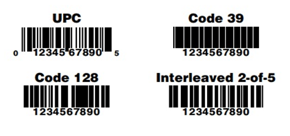With the variety of barcode symbologies currently available, how can you be sure that the one you choose will fulfil your requirements? This guide is a basic reference to help you sort through the options. Additional articles will follow soon with more detail about each symbology on its own, and as always, please let us know if you have any questions or input!
Linear Barcode Symbologies (1D):
Linear Barcode symbologies are likely the ones most people are familiar with. These barcode symbologies are created with parallel black and white bars and spaces of varying sizes and are used to automatically and accurately capture data and reduce human error during entry as they are read by a laser scanner. The scanner reads the barcode from left to right in one dimension which is why linear barcodes are referred to as 1-D barcodes.
Some of the common Linear Barcode symbologies you might come across are
UPC: Standard barcode for retail environments. Each UPC number relates to one specific retail item. Codes are regulated by www.GS1.org and are only produced as static (non-changing) numbers.
Code 39 (or Code 3 of 9): Most common barcode symbology. Codes alphanumeric character set, and is very strong in asset tracking applications requiring sequential data (i.e. 0001, 0002, 0003, etc.).
Code 128: Less common than code 39, but still widely used. It is also  more compact than code 39, so you can fit more characters in smaller spaces.
more compact than code 39, so you can fit more characters in smaller spaces.
Interleaved 2 of 5 (or I 2 of 5): Symbology that requires an even number of encoded digits. Only numeric information can be encoded.
2D Barcode Symbologies
This second category has been gaining popularity in recent times due to their advances in encoding and flexibility of use. 2D Barcode Symbologies have been included in many applications including: print advertisement, social networking, military identification, and much more. These 2 dimensional barcode symbologies are read in 2 dimensions (surprise surprise… they are read horizontally and vertically). Since these are read in both directions, a standard laser scanner will not be able to read these. Instead an optic scanner or smartphone will be required. Typically fashioned as a square shape, 2 Dimensional barcode symbologies are able to hold hundreds of characters on much smaller areas than their 1 Dimensional counterparts.
The two most common 2 Dimensional barcode symbologies you will come across are:
QR Codes: These are most common for applications in advertising as the proliferation of mobile
scanning apps for smartphones has allowed companies to create ‘hardlinks’ that the customer can scan with a smartphone and learn more information right on the spot. However, more companies are starting to utilize the technology in standard asset tracking processes, as the use of smartphones is widespread.
DataMatrix: These barcodes are used regularly in many military applications due t o their robust
o their robust
encoding and error correction ability. A Data Matrix has the ability to be scanned even though it may be damaged. They are also used in asset tracking applications with more regularity due to their ability to hold a lot of information in a very small space.



